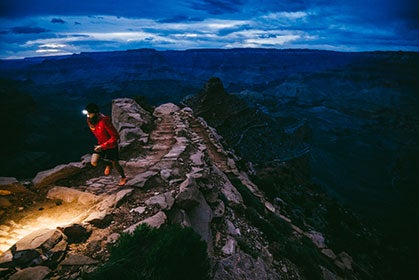Rob Krar’s Tips for Running in the Dark

The 100-mile standout (and frequent nighttime runner) offers advice on tackling the trails at night (sponsored)
Krar runs in the Grand Canyon at dusk. Photo by Ken Etzel
Sponsored by Petzl. Comment below with your advice for running trails at night for a chance to win a Nao headlamp from Petzl (MSRP $185!)
You were planning on a late-afternoon run, but work ran later than expected. By the time you get home, the sun has disappeared, and the local trail looks intimidating, shrouded in darkness.
Running at night can be a daunting venture. What to wear? What to bring? What new dangers to be aware of? As with any new undertaking, it’s helpful to have beta from someone more experienced.
Rob Krar, the 38-year-old Flagstaff, Arizona, resident who burst onto the competitive trail scene a few years back, clocks 100-mile times times so fast that he rarely finishes at night (see, e.g., his back-to-back-to-back wins at the Western States Endurance Run, Leadville Trail 100 and Run Rabbit Run 100 last year). But his busy schedule means that he’s logged plenty of training miles after dark. He offered Trail Runner these tips on what to expect from a night run, and how to best prepare.
Photo by Ken Etzel
What should people look for in a lighting device?
A comfortable and easily adjustable headlamp is a great starting point. If you pass on a headlamp [on an evening run], you’re likely to find yourself wishing you hadn’t when the sun sets quicker than you thought it would. I’ve tried waist and handheld lighting, but nothing beats the simplicity and hands-free convenience of a headlamp.
What are some potential pitfalls to keep in mind when running at night?
Darkness can easily make your favorite trail into something unfamiliar and unrecognizable. Keep focused on your intended route, especially during races. Be ever conscious of your footing and never let your guard down. Lighting creates shadows that can mask rocks, roots and other hazards that can stop your run or race short.
If you’re going out for a training run at night, do you have a preference for a certain kind of terrain or trail?
Risk versus reward is an important factor in choosing where to run at night. If I’m not training for a race that will involve running in the dark, I’ll often minimize risk and choose less technical terrain. If I have a targeted night race I’ll try and mimic the conditions I’ll be racing in to feel more confident during those hours of racing.
Thus far in your career, what has been the biggest learning experience in terms of racing/running at night?
Playing the game of battery life versus brightness can sometimes be a challenge. So many factors contribute to battery life: age of battery, temperature, brightness level, reactive lighting, etc. I learned all too well the pitfalls of pushing my luck during a training run a couple years ago and never leave the door without my “oh shit” ultralight handheld light [as a backup].
Can you recount any particularly memorable night-racing experiences?
Once, I scared myself enough to audibly yelp and jump. I was rounding a turn on a familiar loop when a gap in the pine trees allowed the light from a low-lying full moon to cast a strong shadow into the light of my headlamp. Like something out of a cartoon, I was scared of my own shadow!
What do you like most about running at night?
There’s a quietness and stillness to night that can’t be found during the day. The trails turn into your own personal playground, often shared only with the creatures that shy away from them during the day. Running in darkness with only a beam of light is a unique and fulfilling experience, not to be missed.
What should people pack in their drop bag for the point in a race where it will likely be dark?
Temperatures can drop quickly and significantly once the sun falls below the horizon. It’s important to have an extra layer ready before that happens, not at the next aid station when you’re cold and shivering and having to play catch up. Likewise with lighting; be prepared, before the sun sets, to account for the unexpected.
How does the mental game of a race change at night?
I’ve run thousands of miles with a headlamp and feel very comfortable and embrace the darkness. Running in the dark changes your awareness of where your competitors are. Seeing a headlamp can make it hard to judge distances: you can be closer or farther than you think. Strategy can also come into play–some even turn off their light in exposed areas to gain a potential advantage.
How can runners who are new to running at night overcome the initial discomfort of it?
When I first started out I felt out of place. It’s easy to convince yourself you should be home and inside, and to dwell too much on perceived dangers. The more you get out at night, the more comfortable you will feel. Invest in a bright and reliable light and always carry a backup. Keep your GPS at home initially so you aren’t tempted to hit the same pace as your day runs. Start slow, stay focused and work your way into longer and more challenging terrain as you become more comfortable with the new adventure.
>Related: 7 Nighttime Trail Races (sponsored)